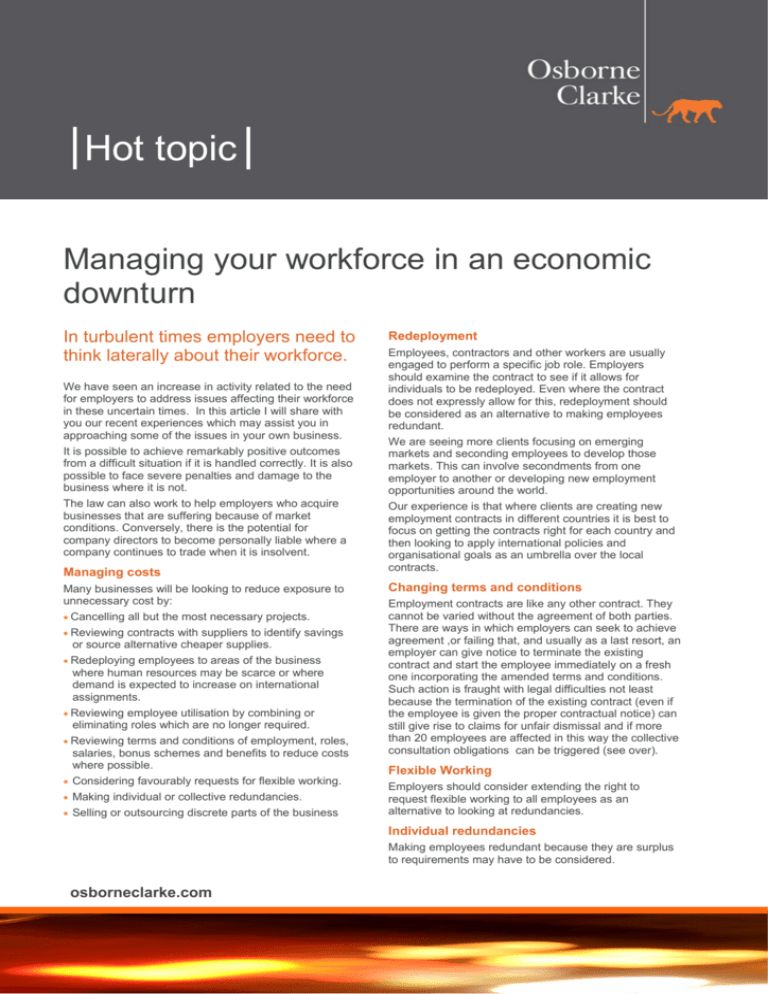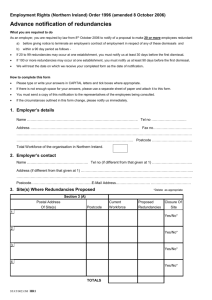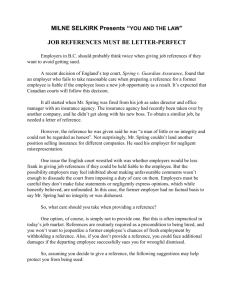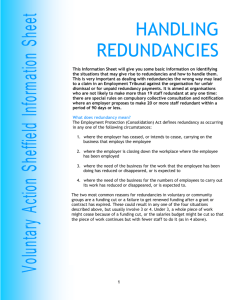Hot topic
advertisement

Hot topic Managing your workforce in an economic downturn In turbulent times employers need to think laterally about their workforce. We have seen an increase in activity related to the need for employers to address issues affecting their workforce in these uncertain times. In this article I will share with you our recent experiences which may assist you in approaching some of the issues in your own business. It is possible to achieve remarkably positive outcomes from a difficult situation if it is handled correctly. It is also possible to face severe penalties and damage to the business where it is not. The law can also work to help employers who acquire businesses that are suffering because of market conditions. Conversely, there is the potential for company directors to become personally liable where a company continues to trade when it is insolvent. Managing costs Many businesses will be looking to reduce exposure to unnecessary cost by: • Cancelling all but the most necessary projects. • Reviewing contracts with suppliers to identify savings or source alternative cheaper supplies. • Redeploying employees to areas of the business where human resources may be scarce or where demand is expected to increase on international assignments. • Reviewing employee utilisation by combining or eliminating roles which are no longer required. • Reviewing terms and conditions of employment, roles, salaries, bonus schemes and benefits to reduce costs where possible. • Considering favourably requests for flexible working. • Making individual or collective redundancies. • Selling or outsourcing discrete parts of the business Redeployment Employees, contractors and other workers are usually engaged to perform a specific job role. Employers should examine the contract to see if it allows for individuals to be redeployed. Even where the contract does not expressly allow for this, redeployment should be considered as an alternative to making employees redundant. We are seeing more clients focusing on emerging markets and seconding employees to develop those markets. This can involve secondments from one employer to another or developing new employment opportunities around the world. Our experience is that where clients are creating new employment contracts in different countries it is best to focus on getting the contracts right for each country and then looking to apply international policies and organisational goals as an umbrella over the local contracts. Changing terms and conditions Employment contracts are like any other contract. They cannot be varied without the agreement of both parties. There are ways in which employers can seek to achieve agreement ,or failing that, and usually as a last resort, an employer can give notice to terminate the existing contract and start the employee immediately on a fresh one incorporating the amended terms and conditions. Such action is fraught with legal difficulties not least because the termination of the existing contract (even if the employee is given the proper contractual notice) can still give rise to claims for unfair dismissal and if more than 20 employees are affected in this way the collective consultation obligations can be triggered (see over). Flexible Working Employers should consider extending the right to request flexible working to all employees as an alternative to looking at redundancies. Individual redundancies Making employees redundant because they are surplus to requirements may have to be considered. osborneclarke.com Redundancy is a potentially fair reason for dismissing an employee and employers should take care that any redundancy falls within the statutory definition of redundancy in the Employment Rights Act. Under the Act an employee is dismissed by reason of redundancy if the dismissal is wholly or mainly because: • the employer has ceased or intends to cease (i) to carry on the business for the purposes of which the employee was employed by him, or (ii) to carry on that business in the place where the employee was so employed, or • the requirements of that business (i) to carry out work of a particular kind, or (ii) for employees to carry out work of a particular kind in the place where the employee was so employed, have ceased or diminished or are expected to cease or diminish. In many cases, redundancies can be limited to those employees who cannot be redeployed and who are in roles that are no longer required. When carrying out any redundancy procedure, an employer must consider (amongst other things): • alternative roles available for the affected employees in the employing company or in a related group company; • the correct pool of employees from which to select candidates for redundancy. Employees can be "pooled" when they have interchangeable roles and skills; • the correct selection criteria, which must not be discriminatory in order to avoid claims for unlimited discrimination compensation in an Employment Tribunal; • the application of the statutory dismissal procedures. Getting the procedure wrong can lead to claims for unfair dismissal (with a potential for a compensatory award up to £63,000 for each employee) and a 50% up-lift in any award for failing to follow the procedure; • whether the employer has a more favourable redundancy policy either written down or through a custom and practice which is contractually binding; and • the entitlement of employees' with 2 or more years' service to a statutory redundancy payment: ways of avoiding compulsory redundancies such as voluntary redundancies, career breaks, temporary laying off and professional "outplacement support" to help redundant employees to find new employment. In any redundancy situation good internal and external communications are vital. Whilst an employer can navigate through this process and often achieve approval from employees for the way a difficult situation has been handled, employers should recognise that the penalties for getting the process wrong can be severe. Employment Tribunals can and do make awards of up to 90 days' actual pay for each affected employee in circumstances where the correct procedures are not properly followed. Our experience is that Tribunals do make these awards which when they are applied to the whole work force can be significant. Transfers of Undertakings Some employers also look to sell or outsource discrete parts of their business in circumstances where the Transfer Regulations ("TUPE") apply. TUPE also imposes an obligation on employers to inform and consult with appropriate employee representatives of the employees who are affected by the sale or outsourcing. These obligations are in addition to the employer's obligations to inform and consult in a collective redundancy situation and often have to be undertaken at the same time. The penalties for failing to inform and consult under TUPE are similar to those for Collective Redundancies and can be awarded in addition. We have already been involved in one case where the employer was facing this "double whammy" from the Employment Tribunal running into millions of pounds. This could have been avoided had legal advice been taken earlier. To achieve a positive result in these circumstances, careful and detailed planning of any redundancy or TUPE process is key before any action is taken. Acquisitions TUPE also applies to the acquisition of a business that is either insolvent or on the brink of insolvency to help buyers to make redundancies or change terms and conditions favourably in order to save the business and the jobs in it. If you are thinking of taking advantage of the economic climate to make acquisitions then you should consider how TUPE might assist you. Company directors Company directors can attract personal liability if they continue to trade the business when it is insolvent and advice should be taken if any director suspects the company may be facing that risk. If you would like to discuss any issues in this article which may impact your business then please contact me or your usual Osborne Clarke contact. Collective Redundancies There are special rules that apply in circumstances where 20 or more employees are to be dismissed which require an employer to inform and consult with appropriate representatives of the workforce. The representatives are either a trade union recognised by the employer or representatives who have been specially elected for that purpose. osborneclarke.com Regulated by the Solicitors Regulation Authority Julian Hemming Partner-Head of Employment Pensions and Incentives julian.hemming@osborneclarke.com © Osborne Clarke July 2008 Publication number 5279524











